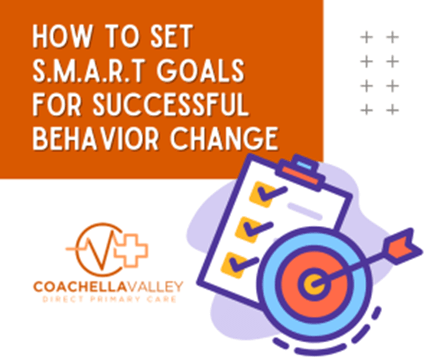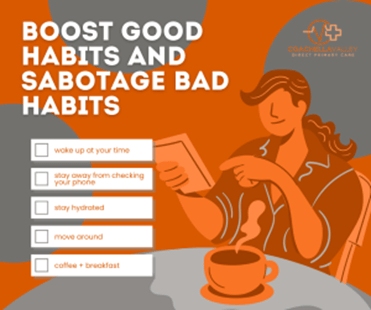Ever wonder why some folks seem to nail their New Year’s resolutions, while others fall off the wagon before February rolls around?
I used to be one of those persons who’d commence a purpose, start off strongly yet rapidly lose impetus. The type who’d set a goal, start strong but quickly lose steam.
“This year, I’m going to hit the gym every day,” I’d proclaim on January 1st, only for my brand new sneakers to gather dust by Valentine’s Day.
The truth is change is hard. Let’s embark on this journey to discover how we can make successful changes in our behavior.
Welcome aboard this enlightening journey where we’ll dive into Tips for Successful Behavior Change. Together, we’ll uncover how setting S.M.A.R.T goals can lead us towards victory and how harnessing social support makes reaching our desired behaviors less daunting.
Coachella Valley Direct Primary Care
Frustration-free health care for the whole family. A monthly membership program designed for the busy Coachella Valley family to give you direct access to primary healthcare services so you can be healthy and active. Schedule a free consultation. 760-642-5549

Table Of Contents:
- Coachella Valley Direct Primary Care
- Understanding the Transtheoretical Model for Behavior Change
- How to Set S.M.A.R.T Goals for Successful Behavior Change
- The Power of Social Support in Behavior Change
- Making Public Commitments for Lasting Change
- Strategies to Boost Good Habits and Sabotage Bad Habits
- Linking New Actions to Existing Habits for Behavior Change
- Mastering the Art of Behavior Change
- FAQs about Tips for Good Habits in 2024
- How can I be successful in behavior change?
- What are the 6 behavior change techniques?
- Conclusion
- Coachella Valley Direct Primary Care
Understanding the Transtheoretical Model for Behavior Change
The Transtheoretical model, developed by James Prochaska and Carlo DiClemente, serves as a guide to understanding behavior change. It consists of five stages: precontemplation, contemplation, preparation, action, and maintenance.
In the precontemplation stage, people aren’t considering any change yet. They’re unaware of their problematic behaviors or simply don’t see them as issues. However, in the next phase—the contemplation stage, they start recognizing these behaviors and contemplate making changes.
Moving onto the preparation stage, individuals begin planning specific actions toward desired behavior modification. The subsequent phase is known as the action stage, where they’re actually executing their plans for better habits.
Finally, we have the maintenance stage, where we aim to maintain our new patterns over time.

How to Set S.M.A.R.T Goals for Successful Behavior Change
To make a real impact on your life, you need clear and achievable behavior change goals. That’s where the S.M.A.R.T goal setting strategy comes in handy.
S.M.A.R.T stands for Specific, Measurable, Attainable, Results-focused, and Time-Bound. These criteria help to shape your aspirations into actionable steps.
- Specific: You’re more likely to succeed if you clearly define what you want. For example, instead of saying “I will get fit,” say “I will lose weight by doing regular exercise.”
- Measurable: Quantify your target so that it can be tracked over time. Decide on a figure for the amount of pounds to be shed, or how many days per week you can commit to exercising.
- Attainable: Your goal should challenge but not overwhelm you – think about small changes like choosing healthy food options regularly rather than radical diet shifts all at once.
The Power of Social Support in Behavior Change
Behavior change can be a lonely journey. But it doesn’t have to be. A significant tool that helps people stick with their behavior change goals is social support.
A study revealed having a partner or accountability routine significantly improves goal achievement. It’s the beauty of human connection – we’re more likely to stay motivated when others cheer us on.
Social engagement, such as joining an exercise group or making healthy food choices with friends, plays a vital role too. The shared experiences not only make the process enjoyable but also keep you accountable and determined.
So next time you set out for your behavior change adventure, remember – don’t go at it alone. Bring along some buddies because together we are stronger.
Making Public Commitments for Lasting Change
By publicly committing to a lasting change, you can leverage the power of social dynamics for motivation and accountability. By announcing your intentions to others, you tap into the pressure and motivation that social dynamics can offer.
Evidence supports this notion. Making a public announcement about your goal has been shown to increase both social pressure and motivation.
The reasoning is simple: once people know what you’re aiming for, they’ll likely ask about your progress. This creates an additional layer of accountability that can help keep you on track toward achieving those desired behaviors.
No one likes falling short of expectations—especially when other people are watching. So go ahead; announce those weight loss targets or plans to quit smoking publicly—and get ready for some real behavior change.

Strategies to Boost Good Habits and Sabotage Bad Habits
It’s not a secret that forming good habits can feel like an uphill battle. But what if you could make it easier? According to studies, making good habits more accessible while placing hurdles before bad ones significantly boosts success rates.
Behavior change techniques, like positive reinforcement or gradual goal setting, can help here. Imagine your favorite healthy food is readily available in your kitchen, while the unhealthy snacks are hidden away – out of sight equals out of mind.
This strategy applies well beyond diet changes too; think regular exercise routines or better sleep schedules. It’s about stacking the odds in favor of desired behaviors while throwing roadblocks at those pesky old patterns we’re trying to shake off.
Linking New Actions to Existing Habits for Behavior Change
Suppose we told you there was an uncomplicated approach to make alteration simpler. Enter the strategy of linking new actions to existing habits. It’s like pairing your morning coffee with reading a chapter from an educational book.
This approach works wonders because our brains already associate certain behaviors together. When one habit is well established, like drinking that cup of joe every morning, adding another action becomes less daunting.
The beauty of this method lies in its simplicity and practicality. You’re not starting from scratch; instead, you’re building on something familiar that reduces resistance and fosters success. Research shows that those who adopt this technique are more likely to achieve their behavior change goals.
Mastering the Art of Behavior Change
The journey to successful behavior change isn’t always straightforward. It often involves a deep understanding of human behavior, coupled with practical coping strategies and goal setting.
A popular approach is using S.M.A.R.T goals – Specific, Measurable, Attainable, Results-focused, and Time-Bound. This technique helps you define clear objectives for your desired behaviors. Research shows that people who use this method have a higher chance of success in their long-term plans like weight loss or quitting smoking.
Maintaining regular physical activity can be challenging but coupling it with healthy eating habits makes it more manageable. However daunting these life changes might seem initially; remember: every big change starts small.
FAQs about Tips for Good Habits in 2024
How can I be successful in behavior change?
To nail behavior change, grasp the transtheoretical model stages. Set S.M.A.R.T goals and link new actions to existing habits. Use social support for motivation.
What are the 6 behavior change techniques?
Six methods include understanding behavioral models like Prochaska’s Transtheoretical Model; setting S.M.A.R.T goals; getting social support; making public commitments; promoting good habits while nixing bad ones; linking new actions with current habits.
Conclusion
Gaining control over transformation is no simple task, yet it can be achieved. With an understanding of the transtheoretical model, we’ve learned how each stage can help us navigate through behavior changes.
S.M.A.R.T goals have proven to be our roadmap for success. They keep us focused and on track with specific, measurable actions that are attainable within a set time frame.
We discovered that social support is key in achieving lasting change. It keeps us accountable and provides motivation when times get tough.
And remember: good habits need fostering while bad ones need sabotaging! This strategy alone can lead to major shifts in behavior over time.
Incorporating these Tips for Successful Behavior Change, you’re now equipped to make your desired behaviors a reality!

